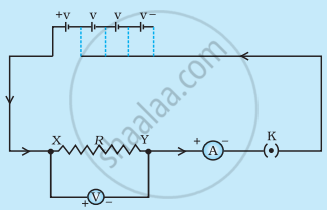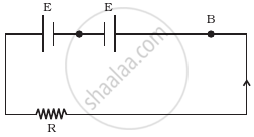Advertisements
Advertisements
Question
State Ohm’s law? How can it be verified experimentally? Does it hold good under all conditions? Comment.
Solution
Ohm's Law states that at constant temperature, potential difference across a conductor is directly proportional to the current passing through it.
Mathematically
V ∝ I
`"V"/"I" = "R"`
where,
V = potential difference
I = current
R = Constant of proportionality and it is called Resistance
Experimental verification of Ohm's law:
Material needed: a nichrome wire, an ammeter, a voltmeter, three cells, key etc.,
Procedure:
- Create a circuit as shown in the diagram, consisting of a nichrome wire XY of length, say 0.4 m, an ammeter, a voltmeter and three cells of 1 V each. Place all the equipment properly.

- First use only one cell as the source in the circuit. Note the reading in the ammeter I, for the current and reading of the voltmeter V for the potential difference across the nichrome wire XY in the circuit. Mark the corresponding readings in the Table given.
- Now connect two cells in the circuit and note the respective readings of the ammeter and voltmeter for the values of current through the nichrome wire and potential difference across the nichrome wire.
- Calculate the ratio of potential difference V to current I for each step.
Then plot the graph between potential difference and the current.
The graph between potential difference and the current is observed to be a straight line passing through origin. The slope of V-I graph indicates the resistance of the circuit. This verifies Ohm's law.S. No. Number of cells used in the circuit Current through the nichrome wire, I (ampere) Potential difference across the nichrome wire, V (volt) V/I
(volt/ampere)
1 1 2 2 3 3 4 4 
Ohm's law does not hold good under all conditions. It is obeyed by metallic conductors only when physical conditions like temperature etc. are kept unchanged and ideal. It is not obeyed by semiconductors, junction diode, thermistor etc. These are called non-ohmic conductors.
APPEARS IN
RELATED QUESTIONS
What will be the change in the current if the potential difference is kept constant and the resistance of the circuit is made four times?
- It will remain unchanged.
- It will become four times.
- It will become one-fourth.
- It will become half.
Why are coils of electric toasters and electric irons made of an alloy rather than a pure metal?
When a 12 V battery is connected across an unknown resistor, there is a current of 2.5 mA in the circuit. Find the value of the resistance of the resistor.
A low voltage supply from which one needs high currents must have very low internal resistance. Why?
An electric bulb draws 1.2 A current at 6.0 V. Find the resistance of filament of bulb while glowing.
State the relation correlating the electric current flowing in a conductor and the voltage applied across it. Also, draw a graph to show this. relationship.
State macroscopic form of Ohm’s law.
The variable resistance is called ____________.
The temperature of a conductor is increased. The graph best showing the variation of its resistance is:
Two cells of same emf E but internal resistance r1 and r2 are connected in series to an external resistor R (Figure). What should be the value of R so that the potential difference across the terminals of the first cell becomes zero.
